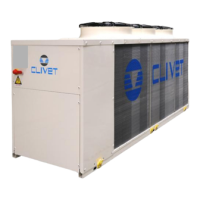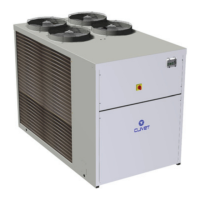
Do you have a question about the CLIVET WSAT-XEE 352 and is the answer not in the manual?
Explains the purpose and usage of the manual, emphasizing safety, warnings, and preliminary information.
Provides general guidelines for installation, operation, safety, risk situations, and intended use of the unit.
Provides step-by-step instructions for safely handling and lifting the unit, including capacity verification.
Details unit installation requirements, including vibration limits, safety, and airflow.
Advises on measures to prevent freezing when temperatures approach 0°C.
Discusses the use of anti-freeze solutions, their impact on pressure drop, and compatibility.
Provides a diagram and list of recommended water connection components and their functions.
Details the free-cooling option, its operation in different seasons, and the use of anti-freeze solutions.
Explains partial and total energy recovery options, including desuperheaters and heat exchangers.
Provides steps for verifying network characteristics, sectioning devices, earthing, and cable sheltering.
Details the components and layout of the electrical panel, listing various modules and their functions.
Covers Modbus RS485 communication, including LED indicators, cable requirements, and bus system setup.
Details BACnet communication, including LED indicators and connection types.
Explains LONWORK communication, including LED indicators, cable types, and specifications.
Lists essential checks to perform before powering on the unit, ensuring safety and proper installation.
Outlines the step-by-step procedure for starting up the unit after installation, including checks and settings.
Reconfirms checks for unit installation, electrical supply, and absence of tension before proceeding.
Details checks for the refrigerant circuit, including oil stains, pressure, and service outlet caps.
Covers checks for the hydraulic system, including cleaning, filling, shut-off valves, and antifreeze solutions.
Guides on verifying electrical connections, conductor tightening, phase unbalancing, and voltage.
Explains the connection and function of compressor crankcase resistances before starting.
Advises checking operating limits, supply voltage, and total absorption during start-up.
Outlines common operations like ON/OFF/ECO, mode change, and setpoint adjustment.
Describes the main menu structure for navigating through unit states, parameters, and scheduler.
Details how to set up events (Off, Eco, On, Recirculating) for each day of the week.
Explains how to view and reset active alarms, including accessing the alarm log.
Provides steps for resetting the alarm log and managing passwords.
Describes how to access the maintenance menu by entering a password and lists available system objects.
Lists alarm codes, descriptions, types, modules, and inputs for various unit faults.
Lists alarm codes, descriptions, types, modules, and inputs for unit faults.
Lists more alarm codes related to pressure, freeze, and flow switches.
Provides step-by-step instructions for connecting the PC to the unit for configuration via LAN.
A checklist of controls to be effected on the unit for maintenance, covering various aspects like corrosions and electrical panels.
Emphasizes that maintenance should be done by authorized personnel to maintain efficiency and prevent damage.
Instructions for authorized personnel to disconnect the unit, avoiding leaks and recovering fluids.
States that the unit must be sent to authorized centers for dismantling and disposal according to national standards.
Signals common situations that are not controlled by the manufacturer and can pose risks.
Defines the danger zone within the unit accessible only by authorized operators.
Warns about risks during handling operations if protections are not used or due to lack of caution.
Highlights risks associated with incorrect installation, such as leaks, shock, and explosions.
Covers risks like burning smells, electrical isolation, and contact with hot components.
Details risks related to electrical connections, sizing, protective devices, and earthing.
Warns about injuries from contact with moving parts like transmissions and fans.
Discusses risks associated with refrigerant, including expulsion from safety valves and explosions.
Covers risks from tubing defects, attachments, or cut-off parts causing leaks or water projection.











